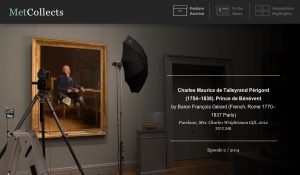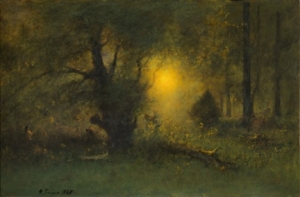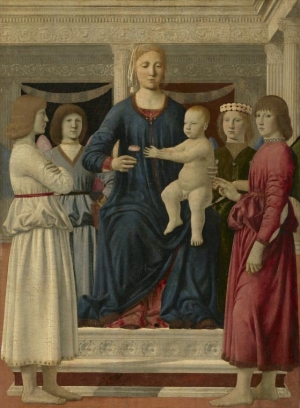|
Displaying items by tag: italian

The Metropolitan Museum of Art in New York has launched MetCollects, a new web series that grants visitors first glimpses of the Met’s recent acquisitions. MetCollects will highlight one work each month, selected from the hundreds of pieces that the museum acquires through gifts and purchases each year. Each MetCollects feature will include photography, curatorial commentary, and occasionally, informative videos.
Three MetCollects features are currently available on the museum’s website. The features explore the following recent acquisitions: a multimedia meditation on time and space by the modern artist William Kentridge, an early 19th century portrait by the French painter François Gérard, and the Mishneh Torah by the Master of the Barbo Missal. The Italian manuscript from around 1457 is jointly owned by the Israel Museum in Jerusalem and the Met.
Since 2000, the Met has launched a number of web-based initiatives including its Connections series, which offers personal perspectives on works of art in the museum’s collection by 100 members of the museum’s staff, and 82nd and Fifth, which features 100 curators from across the Met who talk about the one work of art from the collection that changed the way they see the world.
To view the MetCollects series click here.
On January 28, 2014, the Hill Collection of Renaissance and Baroque bronzes will go on view at the Frick Collection in New York. The Frick will be the only venue for the first public exhibition of the figurative statuettes, which span the 15th through the 18th century. The Hill Collection is exceptional in that it contains a number of rare, autograph masterpieces by Italian sculptors such as Andrea Riccio, Giambologna, and Giuseppe Piamontini.
In an unexpected twist, the show will juxtapose the bronzes alongside modern masterpieces from the Hill’s collection including works by contemporary artists such as Cy Twombly and Ed Ruscha. Collectors Janine and J. Tomilson Hill have spent around 20 years amassing their holdings -- a mix of Renaissance sculptures and works by postwar artists, specifically Andy Warhol, Roy Lichtenstein, Francis Bacon, Willem de Kooning, Lucio Fontana, Brice Marden, Ruscha, and Twombly.
The Hill Collection will be on view at the Frick through June 15, 2014.
The Frick Collection in New York has named Xavier F. Salomon chief curator of the museum, filling a vacant spot left by Colin B. Bailey who departed the institution in June to become director of the Fine Arts Museums of San Francisco.
Prior to joining the Frick, Salomon spent three years at the Metropolitan Museum of Art as the curator of Southern Baroque paintings and before that, he was chief curator of London’s Dulwich Picture Gallery. Salomon is an expert in the work of the Italian Renaissance painter Paolo Veronese and the collecting and patronage of the cardinals in Rome during the 17th century.
Salomon will assume his new role at the Frick in January 2014.
On May 23, 2013, after a two and a half year renovation, the Metropolitan Museum of Art in New York unveiled 45 updated and expanded galleries of European paintings. The new space, which has increased by about a third, boasts 600 works of art dating from 1250 to 1800. Arranged in chronological order and grouped by country, the collection includes the Met’s renowned holdings of early Dutch, French, and Italian paintings.
The reimagined European painting galleries include 23 high profile loans, mainly from private collections. Works by Jan Van Eyck (1395-1441), Nicolas Poussin (1594-1665), Sandro Botticelli (1445-1510), and Peter Paul Rubens (1577-1640) will be on view for at least six months thanks to the generosity of the Met’s trustees, and patrons.
The Met’s European painting galleries have not been fully renovated since the early 1950s and this is the first overall reinstallation of the collection since 1972.

The Minneapolis Museum of Arts acquired a rare Renaissance bust of St. John the Baptist yesterday, May 8, 2013. Created by the Italian sculptor Benedetto da Rovezzano (1474-1554), the terracotta bust was one of the works handpicked by Hitler to appear in his Führermuseum, which never came to fruition. The institution was expected to house a massive collection of the most important works of Western Art in the historical canon.
Rovezzano’s bust was bought from Theresia Willi Lanz by Hitler’s special representative, Hans Posse, who was in charge of traveling across Europe seizing important works from Jewish art collectors and buying them from non-Jewish collectors. After the Führermuseum was never realized, the bust was hidden along with a number of important works by Leonardo da Vinci (1542-1519), Vermeer (1632-1675), and Michelangelo (1475-1564) in a salt mine in Austria. As it became clear that the Nazis would not win World War II, Hitler’s officials called for the destruction of the mine. However, the miners from the Austrian town wished to keep their livelihood intact and worked to save the mines and the art inside by removing inactivated Nazi bombs and setting them off through controlled explosions within the tunnels of the mines, saving the salt and the art but making them inaccessible. The bust was ultimately returned to the Netherlands.
Rovezanno was one of the most prominent sculptors during the high Renaissance and his bust of St. John the Baptist is well known among Renaissance experts. Created in Florence during the time when Leonardo, Michelangelo, and Raphael (1483-1520) were working there, the bust is the earliest Renaissance sculpture in the Minneapolis Institute’s collection. The bust of St. John the Baptist will go on view in the Minneapolis Institute of the Arts permanent galleries alongside other renowned Renaissance busts by Agostino Zoppo (circa 1520-1572) and Giovanni Battista Caccini (1556-1613).

The Sterling and Francine Clark Institute in Williamstown, MA received its largest gift to date from New York-based collectors Frank Martucci, and his wife, Katherine. The Martuccis donated an impressive collection of works including eight landscapes by the 19th-century American painter George Inness (1825-1894).
The gift is extremely beneficial for the Clark, which focuses on collecting certain artists in depth; the museum currently boasts impressive collections of works by John Singer Sargent (1856-1925), Winslow Homer (1836-1910), and Pierre-Auguste Renoir (1841-1919). The Martuccis’ donation strengthens the Clark’s Inness holdings as they had only two paintings by the artist in their collection, which were acquired in 1955. The Martuccis also donated oil paintings by Eastman Johnson (1824-1906) and Gaston Latouche (1854-1913), an early watercolor landscape by Piet Mondrian (1872-1944), and five works by the Italian genre painter Mose Bianchi (1840-1904).
The new Inness landscapes will be featured in the exhibition George Inness: Gifts from Frank and Katherine Martucci from June 9 through September 8, 2013; the show will run concurrently with a major exhibition of paintings, watercolors, and prints by Winslow Homer.
Serbian police recovered Rembrandt’s (1606-1669) Portrait of a Father on Tuesday, March 12, 2013, seven years a after it was stolen from the Novi Sad City Museum located in the northern city of Novi Sad. Police arrested four people in connection to the 2006 heist that involved three other paintings including a work by the Flemish Baroque painter Peter Paul Rubens (1577-1640), a 17th century piece by the Italian Baroque painter Francesco Mola (1612-1666), and another painting from the 16th century by an unknown German-Dutch artist.
Rembrandt, one of the greatest painters and printmakers in European art history, painted Portrait of Father in 1630 and it is estimated to be worth around $3.7 million. The painting was stolen 10 years prior to the 2006 robbery, but it was eventually recovered in Spain.
None of the other works involved in the Serbian heist have been found.

Seven works by the renowned Italian painter Piero della Francesca (1411/13-1492) are currently on view at the Frick Collection in New York. Piero della Francesca in America is the first monographic exhibition in the United States to focus on Piero, one of the founding figures of the Italian Renaissance.
Among the seven works on view at the Frick are six panels from the Sant’Agostino altarpiece (1454-69), a work commissioned for the Church of St. Agostino in Piero’s native Borgo San Sepolcro. Soon after the altarpiece was completed, it was dismantled, removed from the church, and the panels dispersed. Eight panels survive to this day including the four belonging to the Frick, three more, which are housed in European museums, and another belonging to the National Gallery in Washington, D.C.
The Frick’s reunion of the six panels is the largest reassembly from Piero’s masterpiece ever to appear on display. The panels are accompanied by the Virgin and Child Enthroned with Four Angels (circa 1460-70), the only intact altarpiece by Piero in the United States. Acquired by Sterling Clark (1877-1956), the heir to the Singer Sewing Machine fortune and an avid art collector in 1913, the work is now part of the Sterling and Francine Clark Institute’s collection in Williamstown, MA.
The exhibition, which is on view in the Frick’s oval room, is accompanied by a number of lectures, gallery talks, and seminars. Piero della Francesca in America will be on view through May 19, 2013.

A remarkable collection of Italian Baroque paintings worth $155 million has been donated to galleries and museums across the UK. The works were previously part of the private collection of Sir Denis Mahon, a philanthropist and heir to the Guinness Mahon banking fortune who died in 2011 at the age of 100. Mahon, who began collecting in the 1930s, was an avid believer that admission to public museums should be free of charge. In keeping with his wishes, Mahon’s generous gift will be revoked if any institution charges the public to see them.
The Art Fund charity, which oversaw the exchange, announced that the transfer of 57 Italian Baroque paintings has been completed. The National Gallery has received 25 works; 12 paintings went to the Ashmolean in Oxford; 8 pieces are now in the Scottish National Gallery in Edinburgh; 6 works went to the Fitzwilliam Museum in Cambridge; the Birmingham Museums and Art Gallery received 5 paintings; and one work was given to the Temple Newsam House in Leeds. The gift included works by Guercino (1591-1666), Guido Reni (1575-1642), Domenichino (1581-1641), and Ludovico Carracci (1555-1619).
In addition to the sizable donation, Mahon left $1.5 million to the Art Fund and 50 works associated with Guercino to the Ashmolean.

In 2006 The Cardsharps was sold to the late collector and scholar Sir Denis Mahon for just over $65,000 at an auction at Sotheby’s in London. At the time of the sale, Sotheby’s identified the work as being by a “follower” of the Italian master, Caravaggio (1571-1610). However, after his purchase, Mahon identified the work as a Caravaggio original and obtained an export license for the work that put its value at $15.5 million according to a claim filed at London’s High Court of Justice.
Due to their failure to identify The Cardsharps as an authentic Caravaggio painting, Sotheby’s is being sued by Lancelot William Thwaytes, who consigned the work to the 2006 auction. Thwaytes is now seeking unspecified damages, interest, and costs relating to the price difference between the painting’s 2006 selling price and what he believes it was actually worth on the open market that year had it been properly attributed to Caravaggio. Thwaytes claims that Sotheby’s was negligent in its research prior to the work’s sale, leading to its extraordinarily low selling price.
However, Sotheby’s stands behind its belief that the painting is a copy and not a work by Caravaggio’s hand, citing Caravaggio expert Professor Richard Spear and several other leading scholars. Sotheby’s added that their view was supported by the market’s reception to the painting when it was put up for auction.
Mahon, who passed away in 2011, donated 58 works from his collection worth around $155 million to various U.K. galleries.
|
|
|
|
|